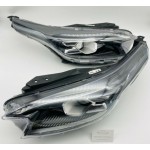
When it comes to car safety, few safety features are as
important and consistently innovated and transformed as the car bumper.
When you buy a bumper,
you have two somewhat conflicting expectations that it is robust and yet will
cushion at least some of the impact of an accident. It manages to achieve this
through a century of development that occurred on the road, in the laboratory
and on the track.
The
Birth Of The Bumper Bar
Very early cars, such as the Royal Enfield and the Benz
Motorwagen, did not have any bumpers at all, which in the latter’s case was
caused by being a motorised trike rather than a car.
The first car with any kind of bumper was released in
1897 in the Czech Republic (at the time part of the Austro-Hungarian Empire).
The Nesselsdorfer
Wagenbau-Fabriks-Gesellschaft (Now Tatra) Präsident resembled a horseless carriage and had tiny metal
bars on the front and back.
At the time, very little was known about car construction
and the bumpers were seen more as a cosmetic feature that provided little
protection in a collision.
The first bumpers designed to absorb impacts were made of
rubber in 1901, but it would take until the 1920s for the bumper to start
becoming more complex and less optional, although they were still primarily
seen as an aesthetic feature placed so low on the vehicle it offered little
protection.
Interestingly enough, whilst the bumper was primarily
separate from the radiator grille, the lights and the exhaust, the first car to
integrate many of these elements together was one of the worst cars ever made:
The Ford Edsel in 1957.
From
Chrome Style To Plastic Protection
Prior to 1952, the idea of the crumple zone or indeed the
forces connected to crashes were not terribly well understood.
The prevailing wisdom was that the safest cars were rigid
and it was about stopping the car from being crushed or debris from entering
the vehicle. However, because the forces generated from a crash have to be
absorbed somewhere, they typically were absorbed by the driver.
Thanks to decades of work by Mercedes-Benz engineer Béla
Barényi, the concept of a car that would deform to absorb impacts was patented
in 1952 in Germany,
which reduced the forces on a driver in the case of an accident.
This was first seen, rather traditionally for Mercedes-Benz,
in their flagship predecessor to the S-Class, the 1959 W111 Tailfin.
However, even this car had chrome bumpers. The first car
to incorporate deforming bumpers into the crumple zone to protect against
crashes was the 1968 Pontiac GTO, which was the first model in a new generation
of Pontiac muscle cars.
It featured a front-bumper known as the Endura, which
could absorb impacts and bounce back and was made from a special form of
urethane foam bonded to a steel frame.
It was infamously demonstrated in an advert where
John Delorean (eventually of the AMC Delorean fame) hit it repeatedly with a
sledgehammer and caused no damage.
This ended up on the similarly designed Plymouth
Barracuda and would eventually make it in the plastic form that would become
standard on the front and rear of the 1972 Renault 5.
By 1973, the US government had introduced regulations
that mandate a certain level of safety in bumpers and the rest of the world
closely followed suit.




























Leave a Comment